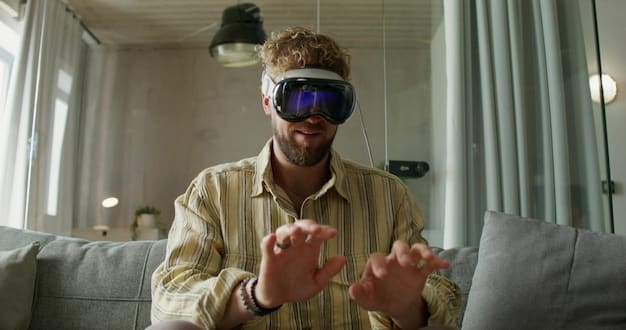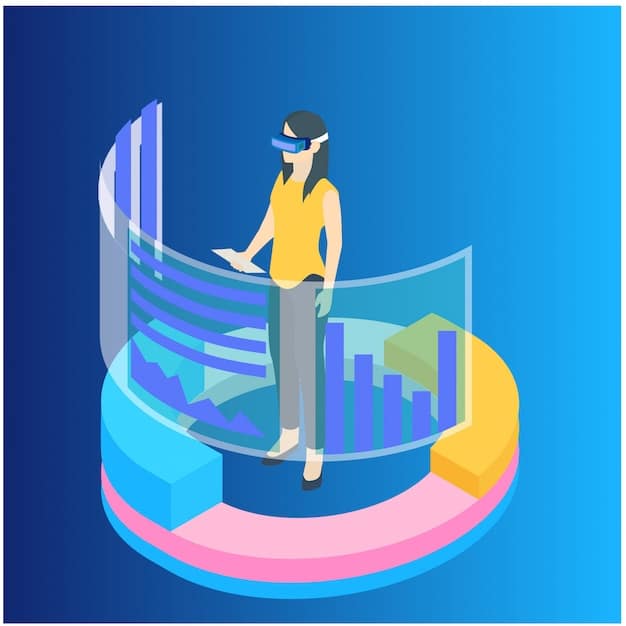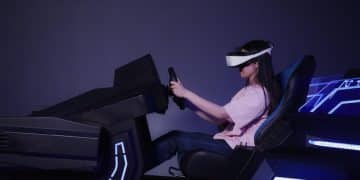PlayStation VR2: Will It Drive VR Gaming Adoption in the US?

VR gaming on consoles, particularly with the PlayStation VR2, aims to revolutionize the gaming experience in the US market by offering immersive gameplay and innovative features.
Can the PlayStation VR2 finally push VR gaming on consoles into the mainstream in the US market? With its advanced features and immersive experience, it aims to capture the attention of gamers and drive adoption.
PlayStation VR2: A New Era for VR Gaming
The PlayStation VR2 represents a significant leap forward in virtual reality technology, offering console gamers an unparalleled level of immersion. With enhanced resolution, improved tracking, and innovative features, it aims to transform how we experience games.
This new VR headset has the potential to captivate a broader audience and establish VR gaming on consoles as a viable and compelling entertainment option in the United States.
Enhanced Visual Fidelity
One of the standout features of the PlayStation VR2 is its significantly improved visual fidelity. The headset boasts a higher resolution display compared to its predecessor, resulting in sharper, more detailed images. This enhanced clarity is crucial for creating a convincing and immersive VR experience.
Advanced Tracking Technology
The PlayStation VR2 incorporates advanced tracking technology, allowing for precise and responsive movement within virtual environments. This seamless tracking translates to a more intuitive and natural gaming experience, reducing motion sickness and enhancing overall immersion.

- Sharper visuals for enhanced realism
- Precise tracking for responsive movement
- Reduced motion sickness for extended play
The combination of enhanced visual fidelity and advanced tracking technology creates a more compelling and accessible VR gaming experience. This is a critical step in driving adoption and establishing VR as a mainstream gaming option.
The PlayStation VR2 sets a new standard for console VR gaming, offering a more immersive and engaging experience that has the potential to drive adoption in the US market.
The Current State of VR Gaming in the US
Despite its potential, VR gaming on consoles faces significant challenges in the US market. High costs, limited content, and technological barriers have hindered widespread adoption. Understanding these challenges is crucial for assessing the impact of the PlayStation VR2.
While VR technology has advanced rapidly, its penetration into the average American household remains limited. Several factors contribute to this slow adoption rate, including the initial investment required and availability of compelling content.
Cost Barriers
The cost of entry into VR gaming can be prohibitive for many US consumers. In addition to the VR headset itself, gamers often need to invest in compatible hardware, such as a high-powered console or PC. This combined cost can deter potential adopters.
Content Limitations
Another challenge is the limited availability of high-quality VR content. While there are some standout VR games and experiences, the overall library is still relatively small compared to traditional console and PC gaming. This lack of content can make it difficult to justify the initial investment in VR hardware.

The limited content and high costs are slowing down the adoption of VR gaming in the US.
Overcoming these challenges requires a concerted effort from hardware manufacturers, game developers, and content creators. Lowering the cost of entry and expanding the library of compelling VR experiences are essential steps in driving adoption.
VR gaming in the US faces hurdles such as cost and content but can continue to grow.
PlayStation VR2’s Unique Selling Points
The PlayStation VR2 distinguishes itself through several unique selling points that could appeal to US gamers. Its integration with the PlayStation ecosystem, innovative features, and exclusive content provide a compelling value proposition.
These aspects make the PlayStation VR2 a strong contender in the VR market, potentially attracting both new and existing PlayStation users.
Seamless PlayStation Integration
One of the key advantages of the PlayStation VR2 is its seamless integration with the PlayStation console. This integration simplifies the setup process and ensures compatibility with existing PlayStation games and services. This ease of use can be a significant draw for PlayStation gamers.
Innovative Features
The PlayStation VR2 introduces several innovative features, such as eye tracking, haptic feedback in the headset, and adaptive triggers on the controllers. These features enhance immersion and provide a more interactive gaming experience.
- Simplified setup process
- Compatibility with existing PlayStation games
- Interactive gaming experience
These innovative features can significantly enhance the VR gaming experience, providing a compelling reason for US gamers to invest in the PlayStation VR2. Eye tracking allows for more natural interactions, while haptic feedback adds a new layer of sensory immersion.
The PlayStation VR2’s unique features and seamless integration set it apart in the VR market, promising to attract the US gamers.
Market Strategies for PlayStation VR2 in the US
To successfully drive adoption of the PlayStation VR2 in the US market, Sony needs to implement effective market strategies. These strategies should focus on addressing key challenges, such as cost and content availability.
A well-executed marketing plan can highlight the value proposition of the PlayStation VR2 and encourage potential adopters to take the plunge into VR gaming.
Pricing Strategies
Pricing is a critical factor in determining the success of the PlayStation VR2. Sony needs to strike a balance between profitability and affordability to attract a broad audience. Offering bundled packages or financing options can help make the headset more accessible to US consumers.
Content Partnerships
Expanding the library of high-quality VR content is essential for driving adoption. Sony can achieve this by forming partnerships with game developers and content creators. These partnerships can result in exclusive VR games and experiences that are only available on the PlayStation VR2.
These content partnerships can significantly enhance the appeal of the PlayStation VR2, providing potential adopters with a compelling reason to invest in the platform. Exclusive VR games, based on popular franchises, can generate excitement and drive sales.
The effective market strategies can overcome obstacles and drive adoption of the PlayStation VR2 in the US.
Potential Obstacles to VR Adoption in the US
Despite the potential of the PlayStation VR2, several obstacles could hinder its adoption in the US market. These obstacles include competition from other VR platforms, technological limitations, and consumer perceptions.
Addressing these challenges proactively is crucial for Sony to maximize the success of the PlayStation VR2.
Competition from Other VR Platforms
The VR market is becoming increasingly competitive, with several players vying for market share. The PlayStation VR2 faces competition from PC-based VR headsets, standalone VR devices, and mobile VR platforms. Differentiating itself from these competitors is essential for success.
Technological Limitations
Despite advancements in VR technology, some limitations remain. Motion sickness, limited field of view, and resolution constraints can detract from the overall gaming experience. Overcoming these technological hurdles is crucial for improving user satisfaction and driving adoption.
- Competition from PC-based VR headsets
- Standalone VR devices
- Mobile VR platforms
These aspects can make the PlayStation VR2 a more attractive and satisfying option for US gamers. Continuous innovation and refinement are essential for staying ahead of the competition and addressing technological limitations.
Overcoming the potential obstacles that could hinder its adoption in the US market is important for Sony to maximize the success of the PlayStation VR2.
Future Trends in VR Gaming
The future of VR gaming on consoles looks promising, with ongoing advancements in technology and evolving consumer preferences. Understanding these future trends is essential for positioning the PlayStation VR2 for long-term success.
Staying ahead of the curve and anticipating future developments will enable Sony to adapt and innovate, ensuring that the PlayStation VR2 remains a competitive offering in the VR market.
Wireless VR
One of the most anticipated trends in VR gaming is untethered, wireless VR. Wireless VR headsets offer greater freedom of movement and eliminate the hassle of cables, resulting a more immersive and convenient experience.
Cloud-Based VR
Cloud-based VR is another emerging trend with the potential to revolutionize VR gaming. By streaming VR content from the cloud, gamers can access high-quality VR experiences without the need for expensive hardware. This can lower the barrier to entry and expand the potential market for VR gaming.
These trends can significantly enhance the appeal and accessibility of VR gaming, paving the way for widespread adoption. Wireless VR provides greater freedom of movement, while cloud-based VR lowers the cost of entry.
VR gaming on consoles has a promising future, with ongoing advancements in technology and evolving consumer preferences.
| Key Points | Brief Description |
|---|---|
| 🎮 Enhanced Immersion | The PlayStation VR2 offers improved visuals and tracking. |
| 💰 Market Challenges | High costs and limited content hinder widespread adoption. |
| 🤝 Strategic Partnerships | Collaborations with developers can boost exclusive content. |
| 🚀 Future Trends | Wireless and cloud-based VR are set to transform gaming. |
FAQ
▼
The PlayStation VR2 features enhanced resolution, improved tracking, and innovative features like eye tracking, providing a more immersive VR experience.
▼
High costs, limited availability of high-quality content, motion sickness, and technological limitations are major challenges hindering VR adoption in the US.
▼
Sony can lower the cost of entry, form content partnerships to expand VR titles, bundle packages, and offer exclusive VR experiences to attract more users.
▼
Cloud-based VR streams VR content from remote servers, reducing the need for expensive local hardware, which can lower VR’s barrier to entry and improve accessibility.
▼
Wireless VR eliminates cables, providing greater freedom of movement, which results in a more convenient and immersive gaming experience.
Conclusion
The PlayStation VR2 has the potential to significantly impact VR gaming in the US market. While challenges remain, its innovative features, seamless PlayStation integration, and strategic market approaches could drive adoption and establish VR as a mainstream gaming platform. By addressing key obstacles and capitalizing on future trends, Sony can pave the way for a VR revolution in American households.





